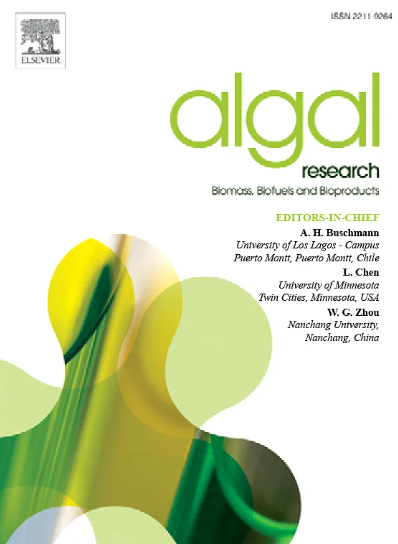来自佛得角群岛蓝藻的次生代谢物作为NO供体,在皮肤病学和化妆品中具有潜在的应用
IF 4.6
2区 生物学
Q1 BIOTECHNOLOGY & APPLIED MICROBIOLOGY
Algal Research-Biomass Biofuels and Bioproducts
Pub Date : 2025-02-07
DOI:10.1016/j.algal.2025.103952
引用次数: 0
摘要
一氧化氮(NO)是一种涉及多种生理过程的多功能介质,其最终目的是维持生物体的稳态。在本工作中,从佛得角群岛分离的十种蓝藻菌株的水提取物被探索作为潜在的NO供体。经PCR和LC-MS分析证实,所有菌株均不产生毒素。其主要成分为藻胆蛋白(9.1 ~ 43.8%),其次为多糖(7.7 ~ 35.1%)、酚类(1.49 ~ 3.3%)和叶绿素(0 ~ 0.45%)。其中,salileptoolyngbya sp. LEGE 181184清除超氧阴离子自由基的IC50值最低(46.50 μg mL−1),抑制促炎酶脂氧合酶(LOX), salileptoolyngbya sp. LEGE 181150的IC25值与阳性对照槲皮素相似(分别为28.49和31.77 μg mL−1),显示了蓝细菌提取物作为抑制LOX的天然成分的潜力。所有提取物均能通过iNOS调节(浓度从12.5 μg mL−1开始)增加巨噬细胞RAW 264.7产生的NO,其机制与LPS相似,且作用范围更广。斑马鱼(Danio rerio)胚胎急性毒性试验(zFET)表明,所有提取物均未对RAW 264.7细胞、内皮细胞hCMEC/d3、成纤维细胞3 T3/L1和角质形成细胞HaCaT细胞系产生细胞毒性,且无环境危害。这项开创性的研究指出,蓝藻水提取物是一种创新的生物基天然抗菌成分,通过no提供机制,可能对重要的抗生素耐药菌株起作用,因此值得考虑作为皮肤病学的治疗剂。本文章由计算机程序翻译,如有差异,请以英文原文为准。
Secondary metabolites of cyanobacteria from Cape Verde Archipelago act as NO donors with potential application in dermatology and cosmetics
Nitric oxide (NO) is a versatile mediator implicated in a variety of physiological processes, with the ultimate goal of maintaining organism homeostasis. In the present work, aqueous extracts from ten cyanobacteria strains isolated from the Cape Verde archipelago were explored as potential NO donors. None of the strains are toxin producers, as demonstrated by PCR and LC-MS analysis. The extracts were mainly composed by phycobiliproteins (9.1 to 43.8 %), followed by polysaccharides (7.7 to 35.1 %), phenols (1.49 to 3.3 %) and chlorophylls (0 to 0.45 %). All the extracts revealed antioxidant potential, with Salileptolyngbya sp. LEGE 181184 presenting the lowest IC50 value for superoxide anion radical scavenging (46.50 μg mL−1), and ability to inhibit the pro-inflammatory enzyme lipoxygenase (LOX), Salileptolyngbya sp. LEGE 181150 presenting an IC25 similar to the positive control quercetin (28.49 and 31.77 μg mL−1, respectively), highlighting the potential of cyanobacteria extracts as natural ingredients for LOX inhibition. All the extracts were able to increase the NO produced by the macrophage cell line RAW 264.7 through iNOS modulation (from concentrations starting in 12.5 μg mL−1), in a similar mechanism and superior extend to that of LPS. None of the extracts induced cytotoxicity to RAW 264.7 cells and to the endothelial hCMEC/d3, the fibroblast 3 T3/L1 and the keratinocytes HaCaT cell lines, and no environmental hazard is predicted, as demonstrated through the zebrafish (Danio rerio) embryo acute toxicity test (zFET). This pioneer study points-out cyanobacteria aqueous extracts as innovative and biobased natural antimicrobial ingredients which, through a NO-donating mechanism, may potentially act against important antibiotic-resistant strains, thus being worth of consideration as therapeutic agents in dermatology.
求助全文
通过发布文献求助,成功后即可免费获取论文全文。
去求助
来源期刊

Algal Research-Biomass Biofuels and Bioproducts
BIOTECHNOLOGY & APPLIED MICROBIOLOGY-
CiteScore
9.40
自引率
7.80%
发文量
332
期刊介绍:
Algal Research is an international phycology journal covering all areas of emerging technologies in algae biology, biomass production, cultivation, harvesting, extraction, bioproducts, biorefinery, engineering, and econometrics. Algae is defined to include cyanobacteria, microalgae, and protists and symbionts of interest in biotechnology. The journal publishes original research and reviews for the following scope: algal biology, including but not exclusive to: phylogeny, biodiversity, molecular traits, metabolic regulation, and genetic engineering, algal cultivation, e.g. phototrophic systems, heterotrophic systems, and mixotrophic systems, algal harvesting and extraction systems, biotechnology to convert algal biomass and components into biofuels and bioproducts, e.g., nutraceuticals, pharmaceuticals, animal feed, plastics, etc. algal products and their economic assessment
 求助内容:
求助内容: 应助结果提醒方式:
应助结果提醒方式:


